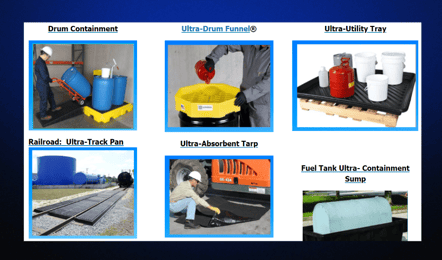What is Spill Containment?

In the complex tapestry of industries, spill containment, coupled with robust spill containment plans, emerges as a vital safeguard against environmental risks and potential hazards. This blog explores the applications that demand spill protection, the far-reaching consequences of a spill, and the strategic measures in place to mitigate these risks, including the pivotal concept of spill containment plans.
Why is spill containment important?
Spill containment is important because it can help to prevent environmental damage, property damage, and health hazards. Hazardous materials can contaminate soil and water, and they can also release harmful fumes into the air. Spill containment can help to prevent these materials from spreading and causing harm.
Understanding Spill Containment:
Applications:
-
Manufacturing Facilities: Industries involved in manufacturing processes often handle hazardous materials. Spill containment measures are crucial to prevent these substances from infiltrating the environment.
-
Chemical Storage Areas: Facilities storing chemicals, whether in warehouses or laboratories, require robust spill containment strategies to prevent leaks and ensure the safety of personnel.
-
Transportation and Logistics: Vehicles transporting liquids, whether on roads or through pipelines, are susceptible to spills. Containment measures are implemented to minimize the environmental impact and protect ecosystems
Exploring Spill Containment Materials:
Discover the diverse world of spill containment materials, each uniquely designed to address specific needs. Here are some common types:
-
Absorbent Materials:
- Examples: Spill socks and pads
- Composition: Clay, vermiculite, polypropylene
-
Containment Barriers:
- Examples: Berms, dikes
- Materials: Concrete, steel, plastic
-
Spill Covers:
- Composition: Large sheets of plastic or other materials
- Purpose: Prevents evaporation and spread
-
Spill Kits:
- Description: Portable kits with various containment materials
- Usage: Ideal for industrial settings prone to spills
Consequences of a Spill:
-
Environmental Impact: Spills can lead to soil, water, and air pollution, adversely affecting ecosystems. Aquatic life, vegetation, and the overall biodiversity of an area are jeopardized.
-
Health and Safety Risks: Spills pose immediate risks to human health, causing respiratory issues, skin irritation, and long-term health problems. Evacuations and health hazards become imminent concerns.
-
Legal Ramifications: Companies failing to implement adequate spill containment measures may face severe legal consequences, including fines, lawsuits, and regulatory penalties.
Mitigating Risks:
-
Strategic Planning: Identifying potential spill points and incorporating spill containment measures into facility designs is a proactive approach to risk mitigation.
-
Training and Awareness: Educating personnel on proper handling procedures, spill response protocols, and the use of containment equipment is crucial for effective risk management.
-
Use of Containment Systems: Implementing spill containment systems such as berms, absorbent materials, and drainage controls helps prevent the spread of hazardous substances.
Understanding Spill Containment Plans:
-
Definition: A spill containment plan is a comprehensive document outlining procedures and protocols for preventing, responding to, and mitigating the impact of spills. It includes strategies to contain, control, and clean up spills effectively.
-
Who Uses Them: Industries dealing with hazardous materials, including manufacturing, chemical production, transportation, and storage facilities, utilize spill containment plans. These plans are essential components of environmental and safety compliance.
-
Key Components: Spill containment plans typically detail spill response procedures, personnel responsibilities, communication protocols, emergency contacts, and the deployment of containment equipment.
Key Components of a Spill Containment Plan:
-
Risk Assessment:
- Identify potential spill sources and vulnerable areas.
- Assess the types and quantities of hazardous materials on-site.
- Evaluate the environmental sensitivity of the surrounding area.
-
Prevention Strategies:
- Implement engineering controls to minimize spill risks.
- Train personnel on proper handling, storage, and transportation of hazardous materials.
- Regularly inspect and maintain equipment to prevent leaks.
-
Personnel Training and Awareness:
- Provide comprehensive training for personnel on spill response procedures.
- Ensure awareness of the location and proper use of spill containment equipment.
- Conduct regular drills and exercises to enhance preparedness.
-
Spill Response Procedures:
- Establish clear communication channels for reporting spills.
- Designate personnel responsibilities and emergency contacts.
- Develop a tiered response system based on the size and nature of the spill.
-
Containment and Cleanup Measures:
- Specify the types of containment systems to be used (berms, absorbent materials, etc.).
- Outline procedures for isolating and controlling the spill area.
- Detail cleanup methods and disposal practices for spilled materials.
-
Communication Protocols:
- Establish a communication chain for notifying relevant personnel, authorities, and emergency responders.
- Provide clear instructions for communicating with the public and media, if necessary.
-
Emergency Contacts and Resources:
- Compile a list of emergency contacts, including local authorities, spill response teams, and environmental agencies.
- Identify and ensure access to necessary resources, such as spill response equipment and cleanup materials.
-
Documentation and Reporting:
- Develop a system for documenting spill incidents, response actions, and outcomes.
- Establish reporting requirements to regulatory bodies and internal stakeholders.
Conclusion: Prioritizing Environmental Stewardship
Spill containment plans are integral to a holistic approach in minimizing the environmental impact of spills. By aligning comprehensive plans with advanced containment technologies, industries can not only comply with regulations but also fortify their commitment to environmental stewardship. Through vigilance, education, and the proactive implementation of spill containment plans, the aim is to create safer, more sustainable operations that prioritize environmental resilience and community well-being.
Choosing the Right Spill Containment Materials:
When it comes to selecting the ideal spill containment materials, seeking guidance from a professional is key. Their expertise allows for a thorough assessment of your requirements, leading to tailored recommendations based on your specific situation.


